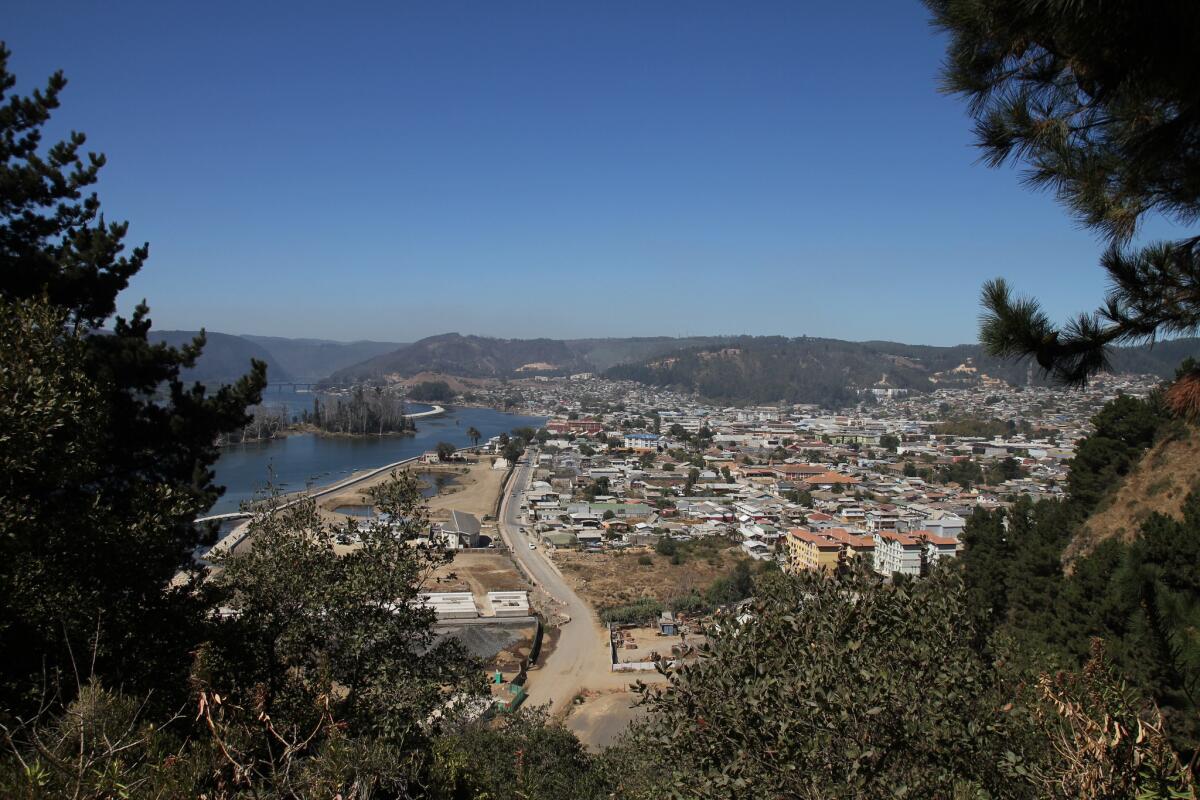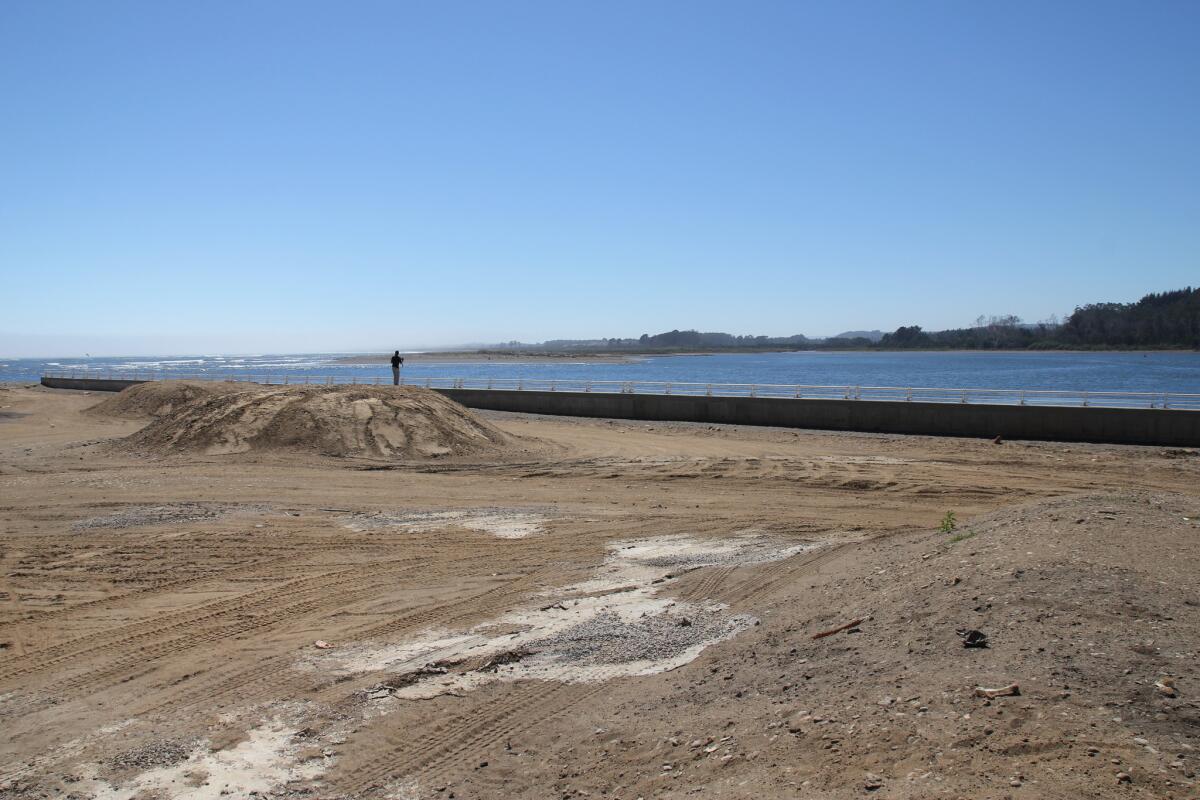Earthquake lessons: A Chilean city develops a new way of living with nature

The coastal city of Constitución in Chile was devastated by an earthquake and tsunami that destroyed settlements along the coast. Now the city is rebuilding — but with climate change in mind.
Reporting from Constitución, Chile — At first glance, the southern banks of the Maule River look positively lunar. The ground is bare, cleared of the construction and landscaping that once covered it. Taking shape are undulating mounds of earth being arranged by a team of earth movers into a design that bears a passing resemblance to some bizarre piece of land art.
Except this is no decorative project. The sculpted terrain is designed to help fortify this central Chilean city of Constitución from seasonal river flooding, occasional tsunamis and rising sea levels. Above all, the project offers a fresh way of thinking about how cities can contend with the ravages of climate: through acceptance.
In 2010, Chile was wracked by an 8.8 magnitude earthquake that rattled the entire Southern Cone and left a trail of devastation from the central port city of Valparaíso to the southern port of Talcahuano, which is almost 400 miles to the south. (Chilean daily El Mercurio has a staggering before-and-after photo essay that chronicled the damage.)
Constitución, a small working-class lumber mill city of 25,000, was especially hard hit. Not only did the city have to contend with the damage of the quake, which crumpled buildings in the historic city center, but a related tsunami — and its attendant 20-foot waves — roared up the mouth of the Maule River and demolished entire swaths of the city’s low-lying areas.
“The devastation was total,” recalls architect Juan Ignacio Cerda of the Chilean architecture firm Elemental. “The city was just destroyed.”
Constitución has come a long way in the last five years.
It still bears the scars of the quake and tsunami in the form of empty lots. But the piles of detritus have been cleared. And the city now hums with the sounds of hammering, drilling and welding. The Cathedral, a bright wood-and-adobe structure whose facade had partly peeled off in the quake, has been rebuilt. A new cultural center has also sprung up nearby. A library and a bus station are in the works. Descending into the town from the coastal hills, visitors are greeted by a brightly painted sign: “Constitución: Una Nueva Ciudad” (“Constitución: A New City”).
In many ways, Constitución is indeed a new city, not just a rebuilt one.
“We could have responded to the disaster with a one-dimensional answer,” says Alejandro Aravena, founding partner at Elemental, the Santiago firm that has overseen the creation and implementation of a new urban plan for the city. “It could have been all about how do you protect a city against a tsunami? Do you re-inhabit or do you build defenses?”
“But in speaking to the people of Constitución,” he adds, “we realized that there were much larger issues. They told us that they’d only ever seen a tsunami once in their lives, but they deal with flooding due to rain every year. The town has been growing, but the public space sucks. So we wanted to hit on something that dealt with the tsunami, but also the flooding and the identity of the city.”
Elemental’s urban planners seized on the opportunity to re-conceive aspects of the city’s design to make it more disaster-resistant but also more livable.
“You can’t talk about tsunamis without dealing with questions of housing, public works and public space,” says Cerda, who was in Constitución during the weeks after the 2005 quake to build emergency shelters and has been Elemental’s point man on the new urban plan. “It’s all connected.”

The southern banks of the Maule River were covered in structures when the tsunami hit. The area has since been cleared and is now being transformed into a park. A series of mounds built into the landscape will serve as wave attenuation during future tsunamis.
The first step for Elemental was to help the city implement a system that would protect it against future tsunamis and seasonal floods. All manner of ideas were put forth: rebuilding the city as it was, constructing a massive concrete sea barrier, and expropriating land among the most hard-hit areas along the banks of the Maule River in order to create a natural buffer zone.
Rebuilding would leave the city vulnerable to future disasters. A barrier would be prohibitively expensive and it was hardly fail-safe (as proved by the sea walls that failed during the 2011 tsunami in Japan). Creating a buffer along the river banks would likely be the wisest course of action, but that would require expropriations — generally a politically toxic idea.
So Elemental’s architects and planners decided to take their initial schemes to the people of Constitución — through participatory design sessions with citizens invited to submit ideas — and in the process, they got a whole lot of feedback.
As Aravena notes in a TED Talk that he gave in the fall of 2014, these sessions were hardly “hippie, romantic, let’s all drink together” discussions. Aravena’s talk includes footage of the architects being yelled at by locals.
“There was one guy that would reject every proposal we submitted,” Aravena recalls. “Who were we but some big Santiago architects coming to tell everyone what to do?”
But the sessions ended up being invaluable since they allowed the architects to understand the city’s most pressing urban issues. Among them: a sore lack of public space. The World Health Organization recommends nearly 100 square feet of green space per person in urban settings. Constitución had less than a quarter of that. If the vulnerable riverfront areas were turned into a public park, the city could achieve a total of 66 square feet of green space per resident.
The expropriations could therefore serve two purposes: creating a natural buffer against storms and tsunamis, while using that very same acreage to create some desperately needed public space.
That, says Cerda, shifted the debate: “We could present the idea differently. It became about building a public park that would democratize access to the river, not just tsunamis.” When the plan was put to a public vote, nine out of 10 city residents voted in favor of it.
The result: the mound-filled landscape that is now being formed on the Maule River.
The park, interestingly, is taking aspects of its design from a small, forested island that sits right in the middle of the Maule. Isla Orrego, as it is known, also suffered damages during the tsunami. But its dense thicket of forest helped slow the waves down.
Constitución’s riverside park — which is scheduled to open in 2017 — will do much the same thing. The series of hillocks will serve as wave attenuation devices and help protect against flooding when the river swells. Planted on top will be a full forest of native trees. When the next tsunami comes barreling through, it will have to pass through this forest before it reaches the edges of the city. The forest won’t stop the water, but it will slow it down.
“Some of the politicians wanted grass — big green lawns in the European style,” says Cerda. “But what we need here is a forest.”
The buffer zone reflects a new, more sustainable way of thinking about nature — of finding ways to live with it rather than building against it.
Likewise, the entire process reflects a unique way of approaching questions of urban design in the wake of a disaster. The whole project is a collaboration between Elemental, local city officials and Arauco, the lumber company that serves as Constitución’s top employer, and which funded the initial study.
“It used to be that if there was a problem, the respective government bureaucracy dealt with it,” says Nelson Bustos, a public affairs and community relations manager at Arauco. “But this was too big. After the earthquake, this was all our problem. We were here too. We lost people too. We helped look for the dead. We used our machinery to clean up the detritus from the storm.”
“So as we talked about rebuilding the city, we wanted to think about how to rebuild,” he adds. “If we were going to make a difference, we knew that it would have to be a public-private partnership. No one can do this alone.”
Elemental, a firm that has extensive experience in socially minded projects such as affordable housing, was tapped. Beyond the tsunami issue, Elemental’s master plan includes plans for affordable housing (partly realized), better evacuation routes (currently being developed) and a fix for the cooked cabbage smell that emanates from the lumber plant (Arauco agreed to install a better ventilation system and the air has improved).
There are also plans for seaside bicycle routes, a swimming pool warmed by leftover industrial steam and specially designed piers for pleasure craft and fishermen.
Cerda says that it is all eminently doable. If implemented in its entirety, the estimated cost will be roughly $150 million. The funds have come from the government, but also the private sector. And in many cases it has been a matter of working with budgets that were already in place.
“A single piece of land might be governed by a number of different government agencies,” says Cerda. “You have the Organization of Ports, you have the Department of Water Works, you have the Highways Administration, you have the Ministry of Housing. If you can get them working all together, it can make a real difference. In all of this, the real scarcity is not money, but coordination.”
All of it serves as an interesting model for other cities in low-lying areas: learning to live with nature rather than fight against it, and learning to look at problems holistically rather than one element at a time. It’s also an interesting case study for architects, whose focus on ideas often comes only one building at a time.
“For us, this isn’t about being some big design hero and creating all these new things,” says Cerda of his and Elemental’s role in Constitución. “It’s about supporting the good ideas that are already there. And they’re there. You just have to support them.”
Learn more about Elemental’s Constitucion project at elementalchile.cl.
Find me on Twitter @cmonstah.
More to Read
The biggest entertainment stories
Get our big stories about Hollywood, film, television, music, arts, culture and more right in your inbox as soon as they publish.
You may occasionally receive promotional content from the Los Angeles Times.











